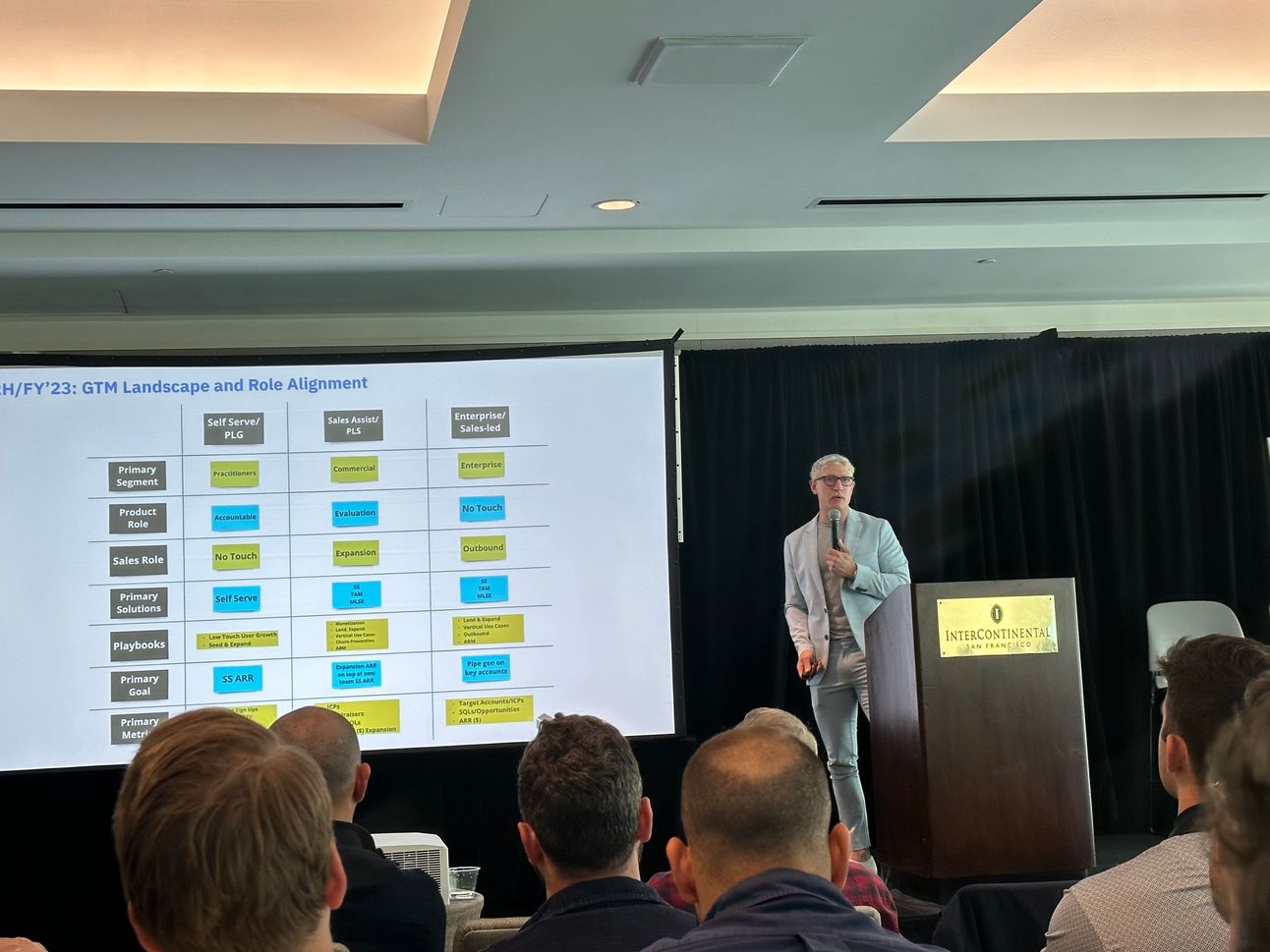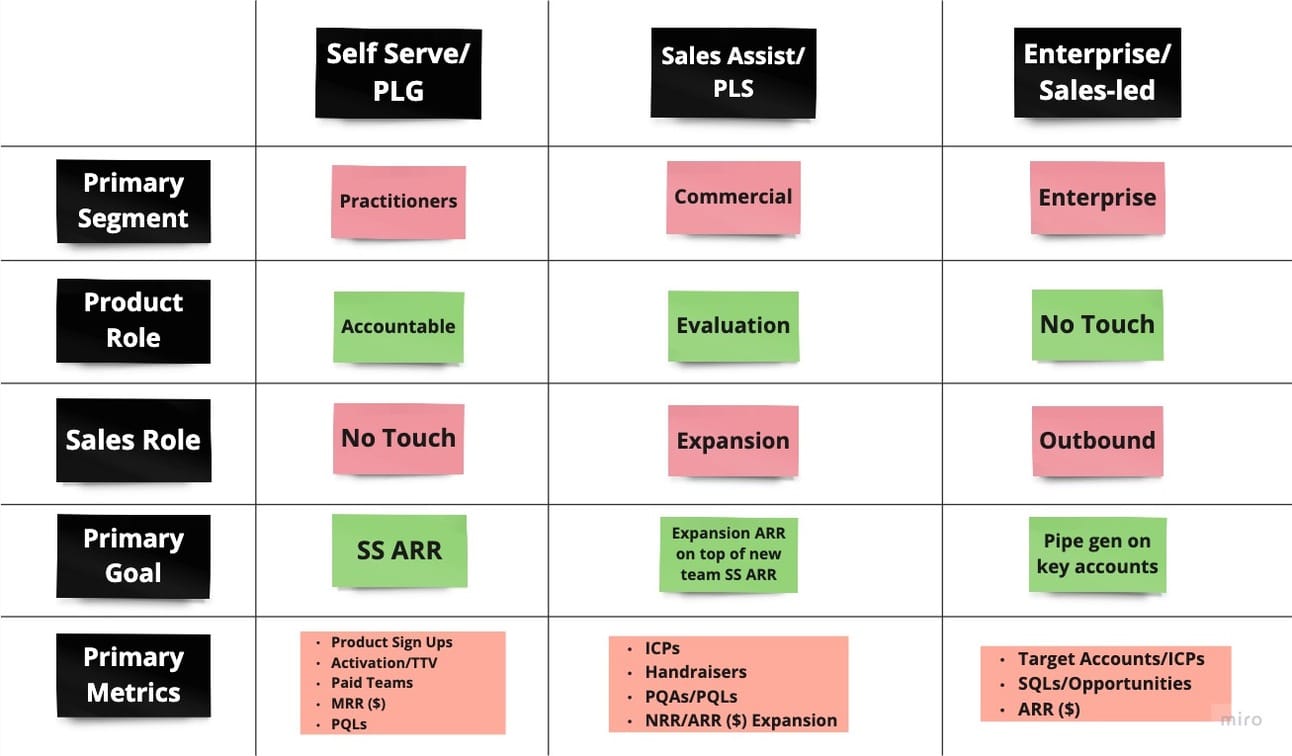Three significant Go-to-Market (GTM) motions exist:
Self Serve/Bottoms Up
Enterprise/Top Down
Sales Assist/Product-led Sales.
Without laying the foundation for these GTM motions, product-led sales will fail.

Here I am presenting a few slides about GTM and Growth to Labelbox
I am 3 weeks into my new role as Director of Growth at Labelbox where last week, we headed to San Francisco for the 2023 all-hands Summer Summit.
Labelbox is a data-centric AI platform for building intelligent applications.
The week was full of presentations, team-building exercises, and brainstorming sessions. We laid out the vision and strategy for the next half year and onwards for the company!
I had the privilege to get an early start and presented to the team on Growth, GTM motions, PLS, and hosted a journey mapping brainstorm!
The GTM Landscape Map

GTM Landscape Map
The difference between GTM motions and Growth motions is that GTM explains the strategy of distributing value to your target market, how that target market enters the product, and experiences value. The growth motions such as PLG and SLG (sales-led growth) depict which part of the org’s resources drive acquisition, retention, and monetization.
Layering GTM motions and Growth motions on top of each other help tell the full story. The Self-serve GTM motion is mainly through product-led growth where the product is primarily accountable for acquiring self-serve users. The Enterprise GTM motion is mainly through sales-led growth where the sales team is primarily accountable for acquiring target accounts.
The middle GTM motion is Sales-assist, which is where the Product-led Sales growth motion lies. It’s not easy to just introduce a product-led sales motion. It requires teamwork, understanding, and alignment between product, sales, and marketing teams. Usually, there is a lot of friction between product, marketing, and sales teams when a PLS motion is introduced because no one really knows when and where sales should be injected.
By separating out the GTM motions like swimlanes, you can explicitly show how each department is responsible and which metrics are key in each motion.
My preference is to depict the GTM landscape map as a flow diagram.
The GTM Flow Diagram

The Product-led sales GTM tunnel
The flow map is similar to the landscape map in that you have self-serve on the left, enterprise on the right, and sales assist in the middle. However, the flow diagram spells out the steps at each stage. No matter where you start, the goal is to get to Enterprise pipeline.
The primary goal of PLS is to create a repeatable process for identifying PQLs from your active self-serve user base that generates enterprise pipeline/revenue.
5 reasons why you should lay out GTM motions
1. Team Alignment
Defining GTM motions help align the various teams involved - sales, marketing, and product. Each team knows exactly what their roles and responsibilities are at each stage of the customer's journey. They can work towards a common goal without any confusion or overlap, fostering better communication and synergy amongst the teams.
2. Improved Customer Journey
A clear GTM motion in a product-led sales strategy provides an optimal path for the customer's journey. It ensures that the customer transitions smoothly from product to sales-assist to enterprise pipeline, enhancing their experience and increasing the likelihood of conversion and expansion. Understanding and outlining these motions can help to pinpoint any potential bottlenecks or pain points and address them proactively, leading to a more streamlined and frictionless user experience.
3. Data-Driven Decision-Making & Integrity
Each phase of the journey can be measured and analyzed independently, providing insights into tactics and metrics like acquisition, PQA conversion rates, and more. This granular data can help teams identify what's working and what needs improvement, leading to more data-driven and effective decision-making processes. Additionally, if each team understands their role and the metrics they're accountable for, the data collected will be more reliable and accurate. Also, it reduces the chances of data silos where valuable information is kept separate by team or function. Siloed teams and data are a recipe for catastrophe.
4. Scale Enterprise Pipeline through PQA/PQLs
A well-defined GTM motion helps provide a systematic process and repeatable efforts for defining the PQA motion. Through trial and error, experimentation, and strong data integrity, you can scale the process for when to inject sales into the GTM user journey. When you unlock this, you create a flow of enterprise pipeline via the self-serve PLG motion!
5. Optimization of Resources
You can better understand and optimize resource allocation when you know exactly the roles and responsibilities of every team. If every team is working on the same thing, the growth engine turns into a soccer game full of 5 years olds where everyone is rushing toward the ball.
Remember - defining language, verbiage, and meaning helps bring more clarity. With more clarity, you have a higher potential for understanding and buy-in. With buy-in, you have motivation for teamwork and execution. With execution, you have output. With output, you can complete a feedback loop. And scale is only a few hundred loops away!
Thanks for taking the time to stop by today!
Was this forwarded to you? Subscribe with one click.
If you're finding this newsletter valuable, please share and spread the word if you can!
See you next time 👋
